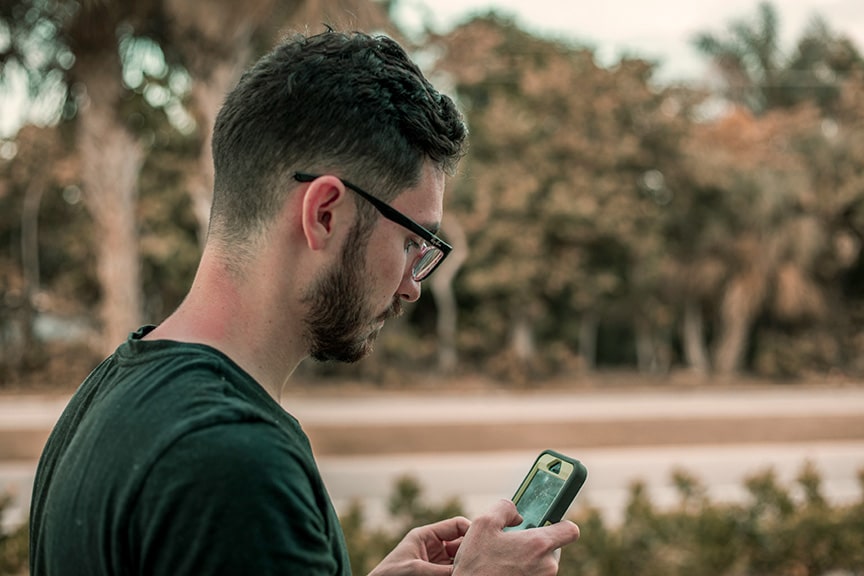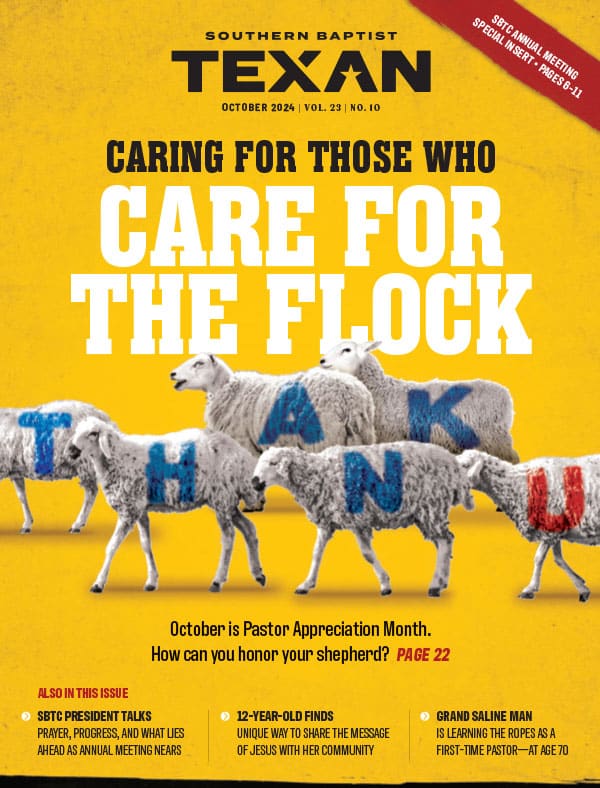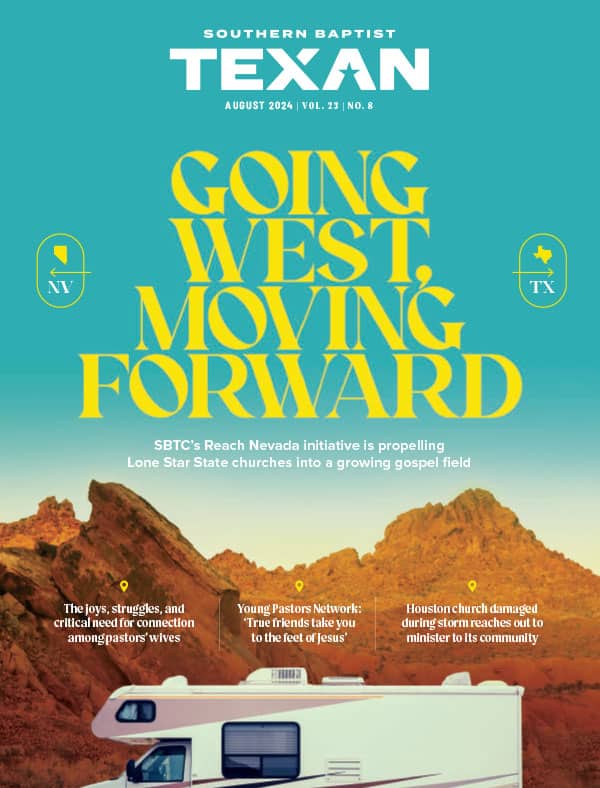|
Related article: Joy by design EDITOR’S NOTE: In examining the work of artist Christians, The TEXAN interviewed three professional painters. Each has worked as a painter for several years. All three are Southern Baptists.
Describe your style for us. Caffy Whitney: Realist, my art is primarily representational.
Dan Addington: It’s more accurate to think of what eras have influenced a painter. Mine most resembles romantic and expressionist painters. Steph Roberts: I describe my work as figurative, both in the sense that the main subject is fairly representational and in the fact that the subject is literally a figure. The space around the figure, however, is not representational at all. This is where an abstract approach takes over in my use of flat space, poured paint, graphic elements, and textural effects. This juxtaposition of a volumetric figure on a flat painting surface can be seen as a nod to postmodernism, in the separation of the diver from its “normal” context and its combination with an abstract picture plane. My work has evolved away from a consistent representational approach, where the painting acts like a window upon a scene. In some ways my paintings have incorporated the ideas of modernism, with the paintings asserting themselves as flat objects. I am less interested in creating the illusion of looking “past” a painting at the objects within. When I admire a painting, it’s not often that I am actually admiring the subject itself (“What a beautiful tree”), but instead I’m admiring the way the paint is handled in its depiction (“What a nice passage of yellow-green …”). What’s it like to be Christians in the art community? DA: I have often felt like a man without a country. Visual arts are often looked on as a frivolous pursuit or as suspicious by the church. I went to a Christian college. Even there, the visual arts were regarded with more suspicion that the performing arts because it was not easily used as a tool for evangelism. Meanwhile, I was attempting to function in a secular art world that often looked suspiciously at believers. I often felt that the most rabid secularists in the art world were still more accepting, even intrigued, by the faith element in my art than evangelicals were by the art element in my faith. I feel that is changing, and I think it has something to do with Christian institutions of higher learning. SR: When I was in graduate school, I was questioned about my explicitly Christian subject matter and the reasons behind it. One professor felt they were “preachy”, and asked if I would be open to making work about other narratives besides ones taken from the Bible. This seemed to me to be beside the point because a main emphasis in developing one’s work in art school is honing your personal statement. What is the point of an artist making work about something with which he or she has no connection? It becomes illustration then. CW: In my mural work, I’ve had opportunity to come in all kinds of environments and settings with construction workers. They all make jokes, call me “Michealangelina,” but almost every time I’ve been in that environment, the Lord has given me an opportunity to witness to those individuals. It’s been amazing to see. Just the other night I went to an art council meeting of community artists. I went with the intent of affecting the arts in our community with the gospel. It’s exciting to me to be an influence there where I can be with non-believers. Does your art idealize or exaggerate reality in order to convey a message? SR: It is an intent of my work to emphasize the physical tension in the divers’ bodies. The figures aren’t done in a photographic style because I enjoy the sense of vitality and agitation in the viewer’s eve that comes with broader brushwork and textural paint application. DA: Art is a very subjective thing. I’m interested in work that seems to have a unique point of view. I would rather be challenged by something I don’t quite get in the first few minutes of viewing, than be assured by something that is quick and easy. CW: I think I do that, to make a statement. It is my job to create the image or idea or the emotion from the painting so that the viewer can interpret that. Is abstract art a fit tool for communicating truth? DA: When I talk to students and they question the relevance of abstraction, I try to get them to forget about visual art and the think about music. Instrumental music, Classical, Jazz, etc. is essentially abstract—it’s formal, yet it has an expressive element. So ask the same question but substitute Mozart. Can eternally true things be communicated through a great work of Classical music… through a great Jazz performance? I think so. It can happen in a painting, too. CW: It’s an artwork with no apparent reference to reality. The abstract artist uses art elements such as color, shape, form, value and texture to create a visually stimulating composition. He’s not concerned with the mere appearance of something that one could easily recognize like with realism. He seeks the inner, invisible reality. That leaves the interpretation of the painting to the viewer. Abstract art has value because it does express intense feelings, moods, and life that can’t be defined in representational art. The Christian who is a n abstract artist is leaving much of the interpretation of the piece to the person who views it. SR: One of the things I enjoy about abstract work is its ability to engage the viewer on many levels When the subject matter is not screaming its name at the viewer, he or she is more free to read the painting in broader ways. I find myself getting lost in the materials themselves, the tactile qualities of the surface, or even experiencing it on a sensation level. When the left brain isn’t dominating the experience of art, the viewer can be more open to emotional connections with it. What is or should be the impact of art in the lives of non-artists? The church? SR: As a Christian artist, I hope for more integration of the visual arts as a viable expression of faith. I do acknowledge that there is a comfort and encouragement derived by many people from earnest examples of popular Christian art. But we should not exclude art from our experience because it is not overtly Christian. There is a place for challenging works that express struggle or suffering as a part of one’s journey. We do not edit out the unpleasant passages of the Scriptures, but embrace them as part of what deepens our understanding of God. Works of art that are aesthetically excellent can enhance our experience as created and creative beings. CW: Just like anything else that we’re not familiar with, it’s an opportunity to go beyond our comfort zone—beyond the mediocrity of what we’re used to. A lot of what Christians see as good art has a Jesus junk mentality. Just because something sells and is popular doesn’t mean it’s good art. It [understanding what’s good and valuable in a piece] takes time, it takes study. It takes going to a museum and spending time looking beyond your first emotional reaction to a painting. DA: I don’t think there’s anything wrong with entertainment, which is how I would classify [more populist art forms]. Sometimes my soul wants more than junk food. It tastes great, and it’s not always bad for you in moderation, but is that all I should be eating? I believe God speaks great truths to us through art, created by artists. And like much healthy food, it can be an acquired taste. The artists don’t have to be Christians and the art doesn’t have to have Christian themes. Truth is the greatest Christian theme anyway. I feel like we should be discerning when it comes to quality, and pastors and teachers should lead. Protestants have a big hurdle to get over when it comes to the visual arts. The thing is, God has given the body of Christ many gifts. As a community of believers we should actively encourage artists to take their place in the church.
|














